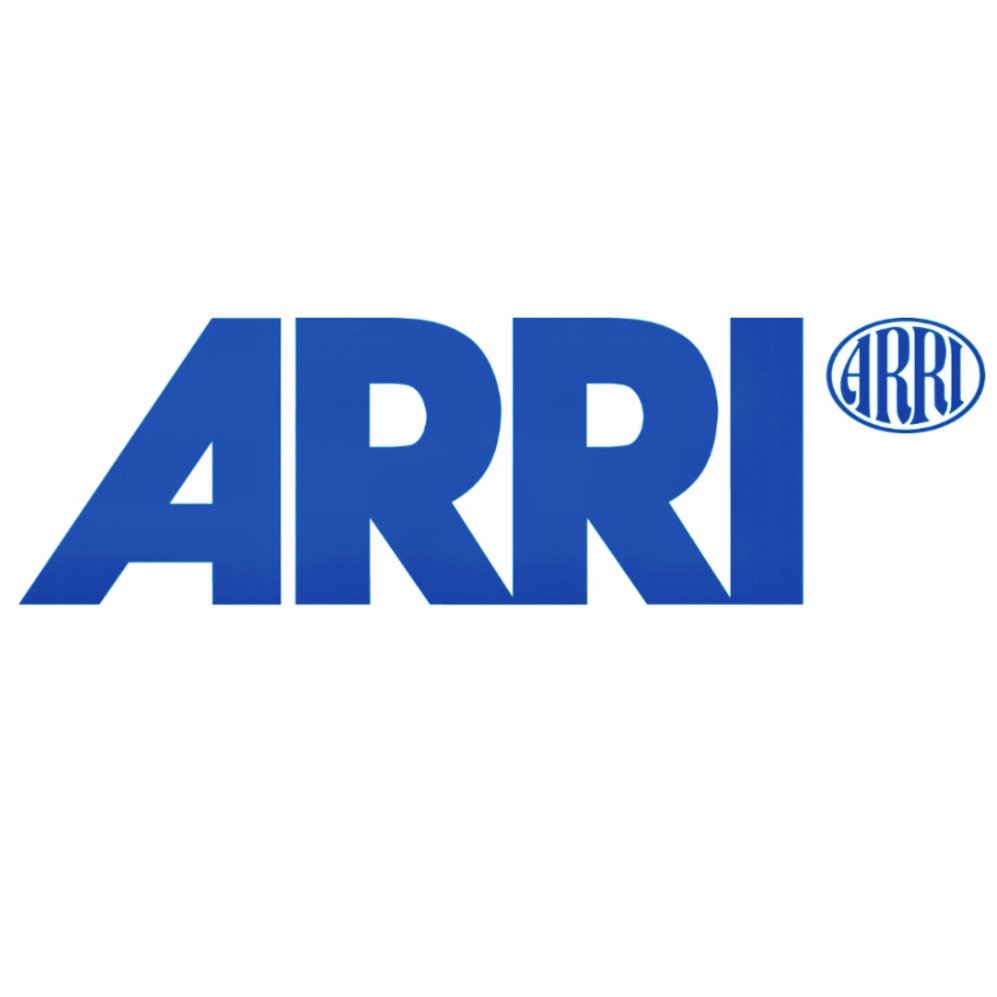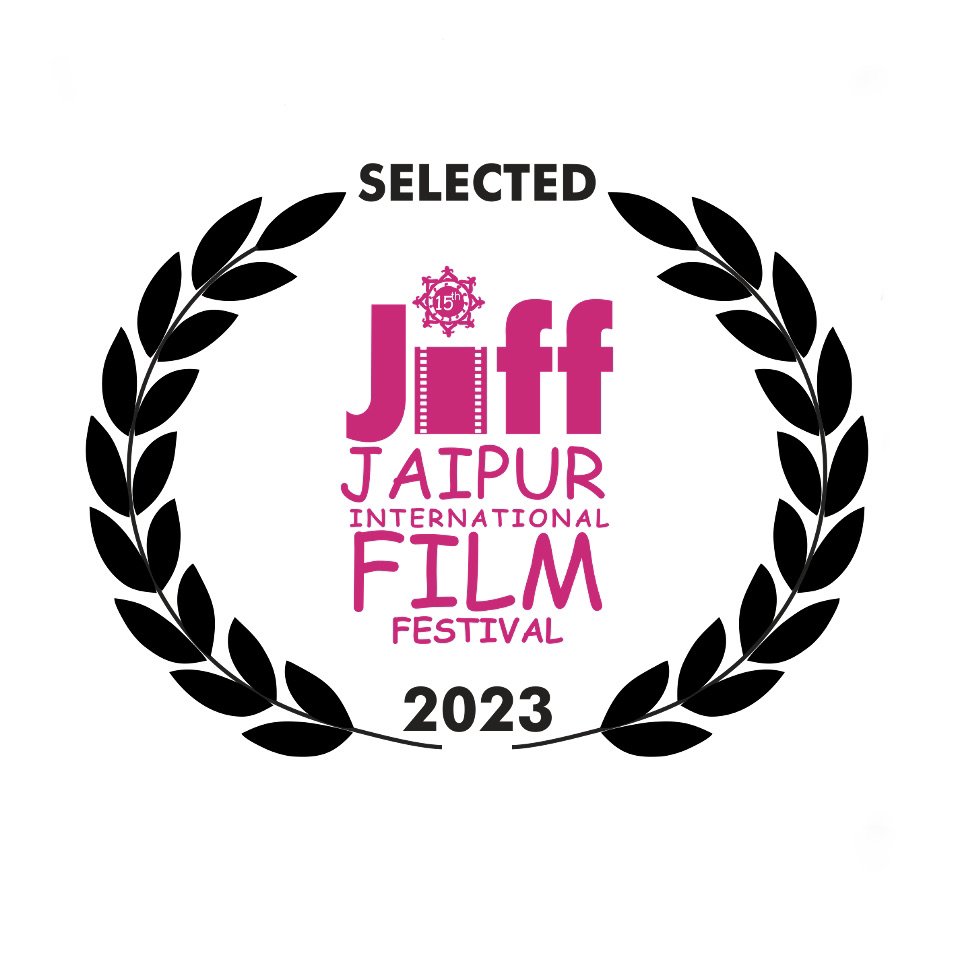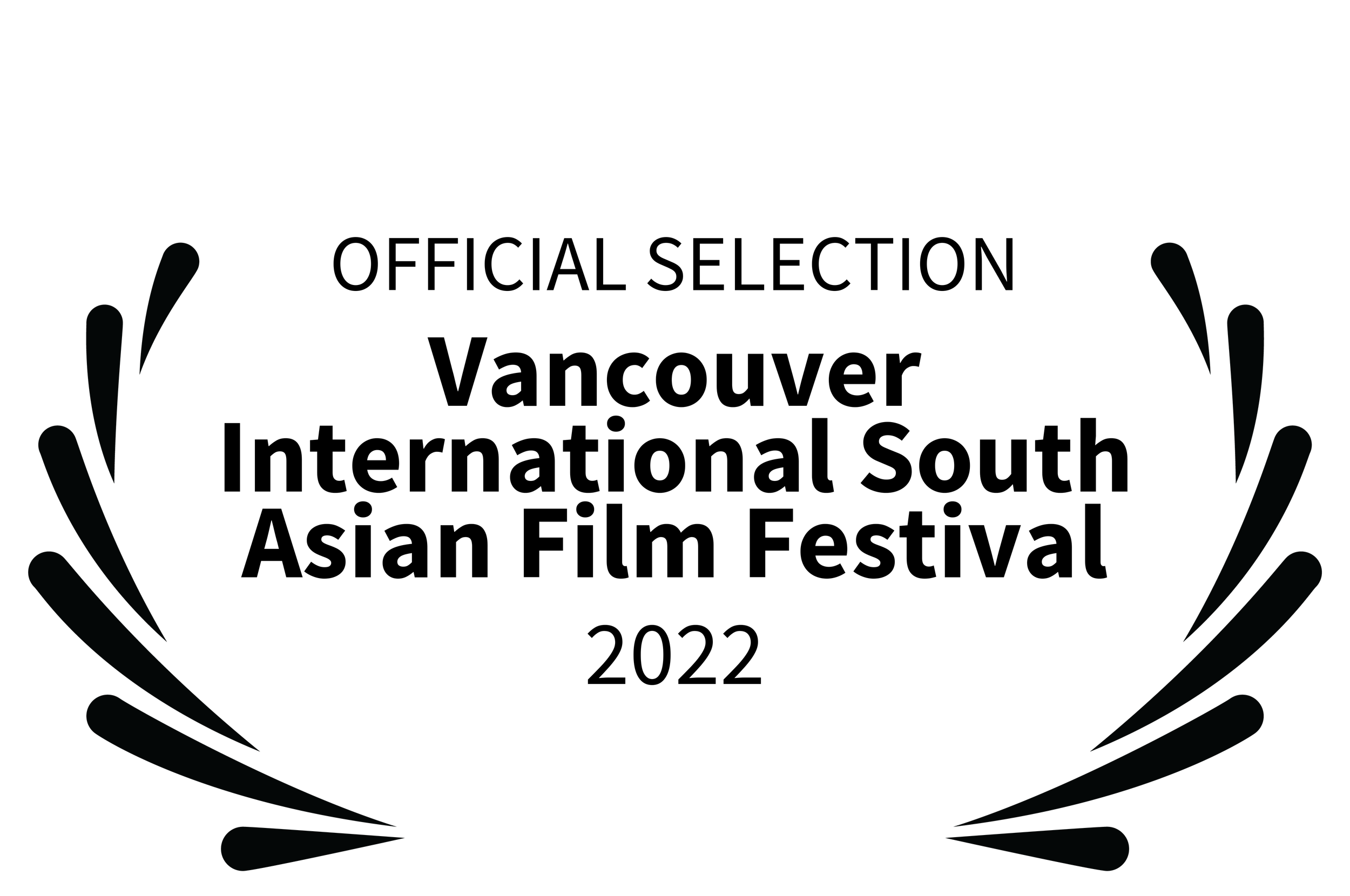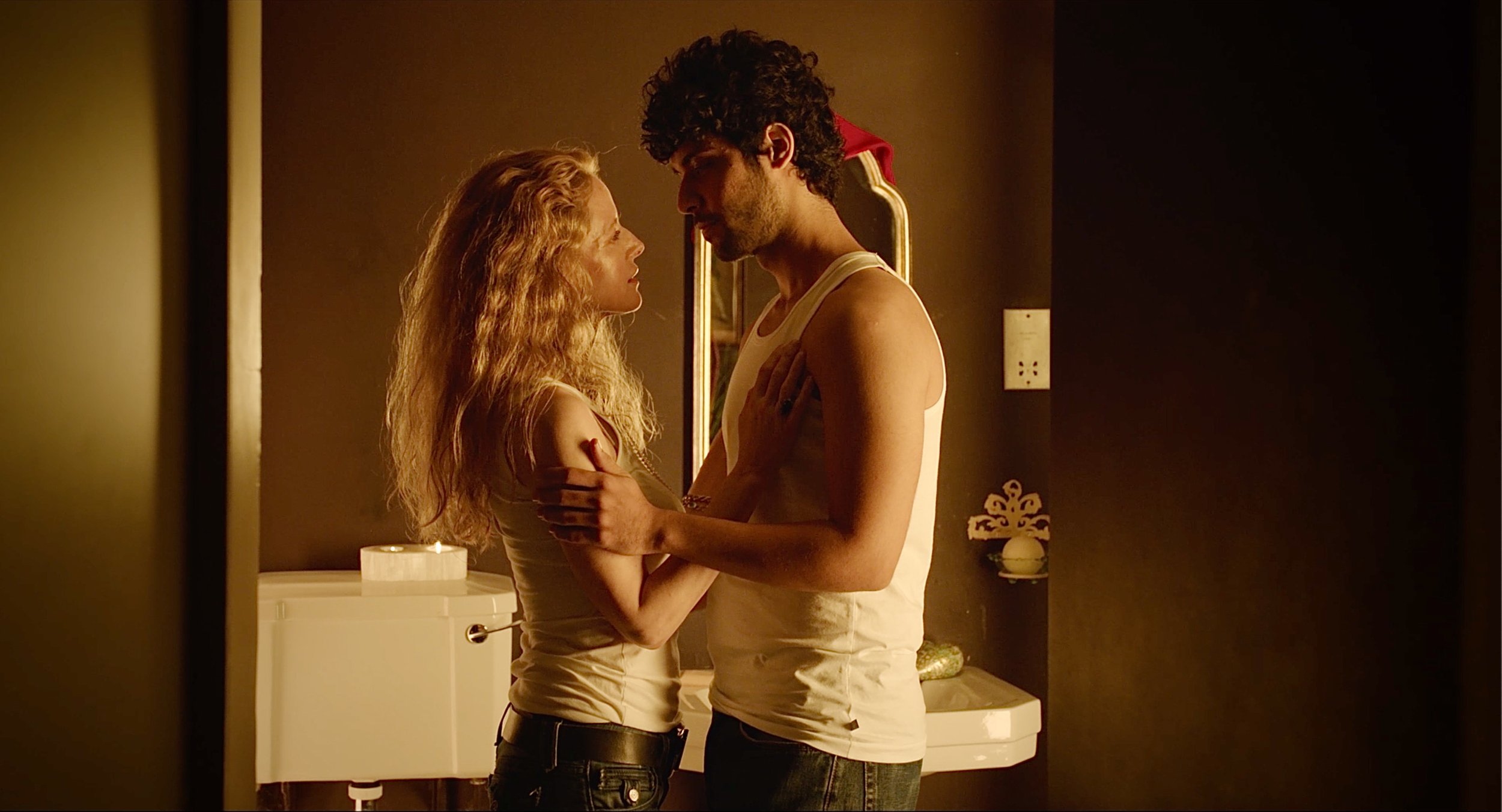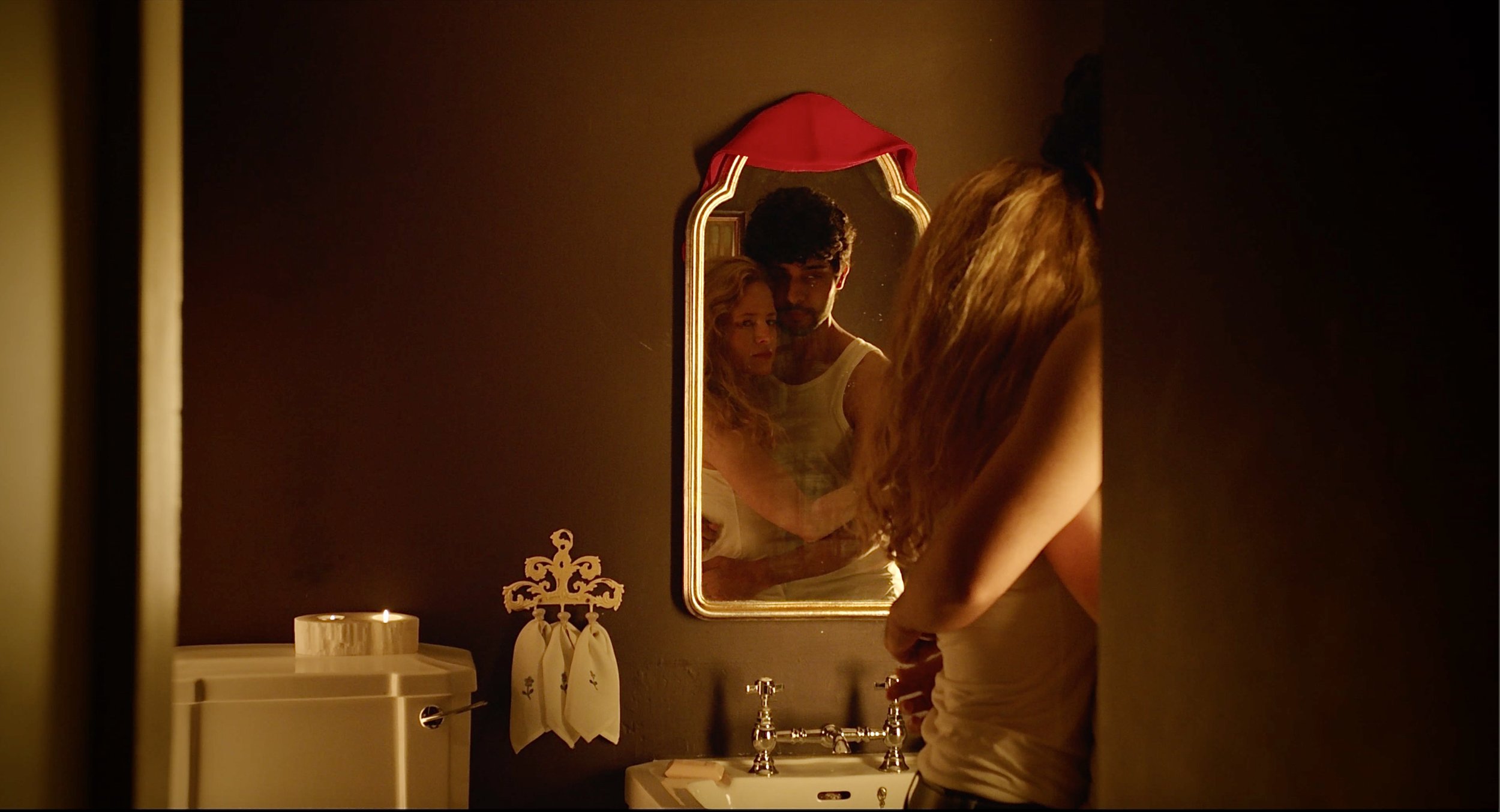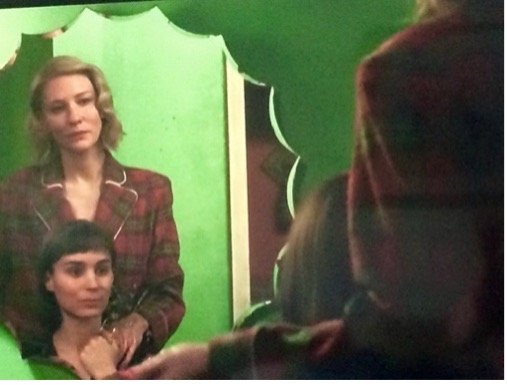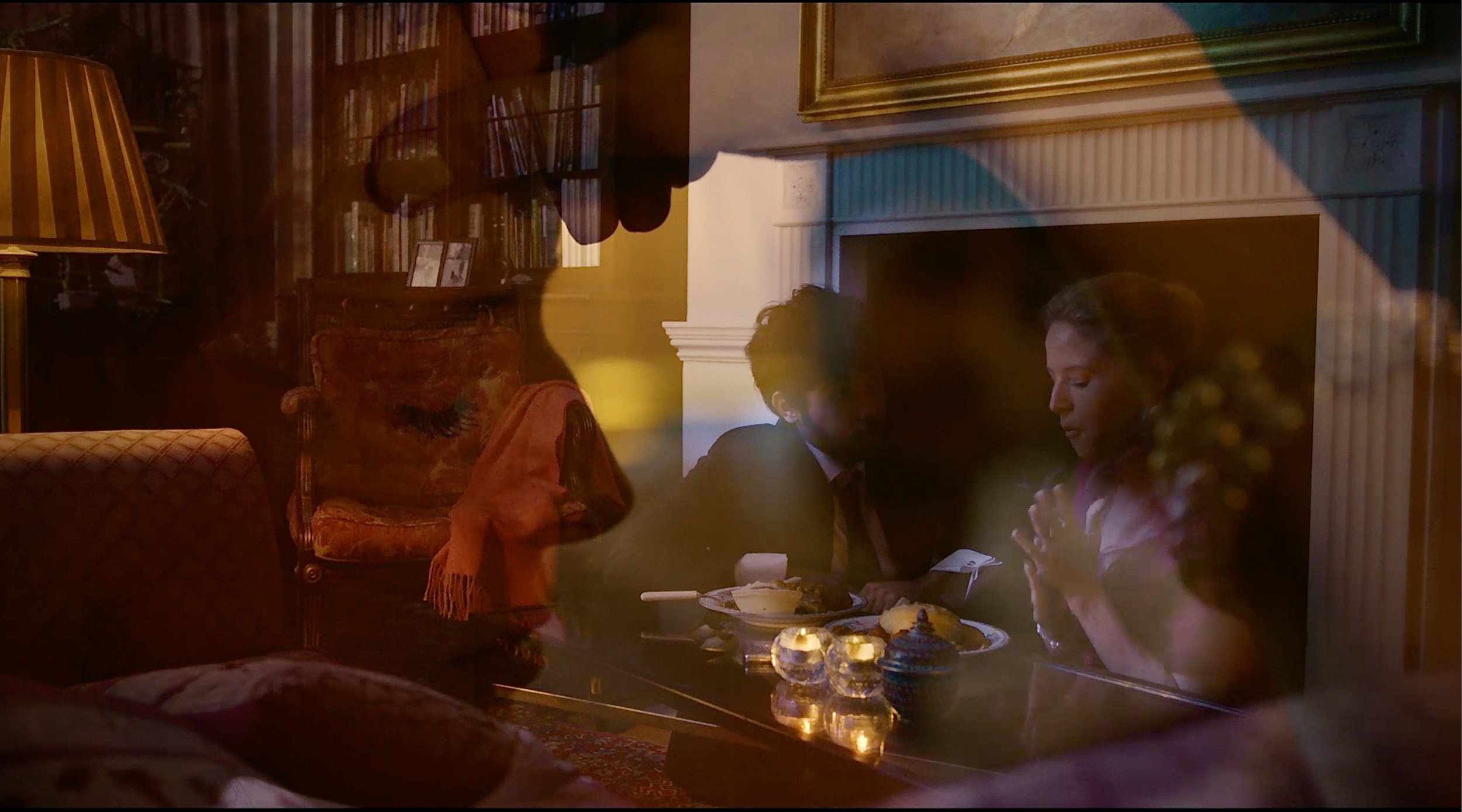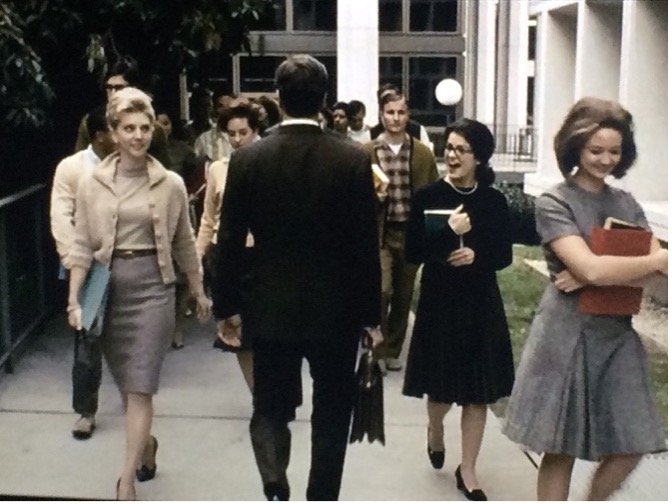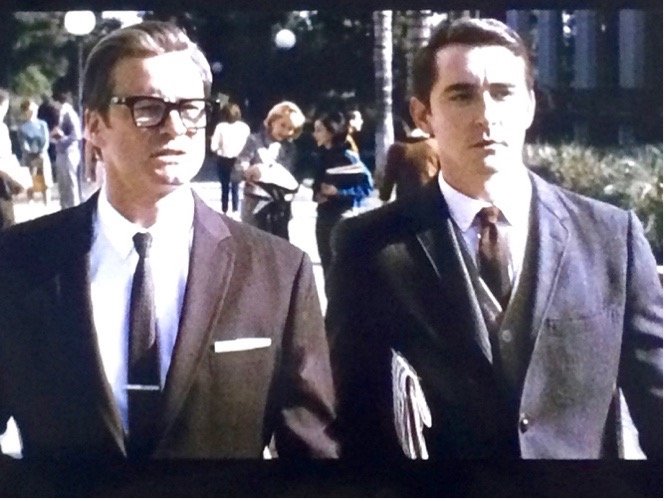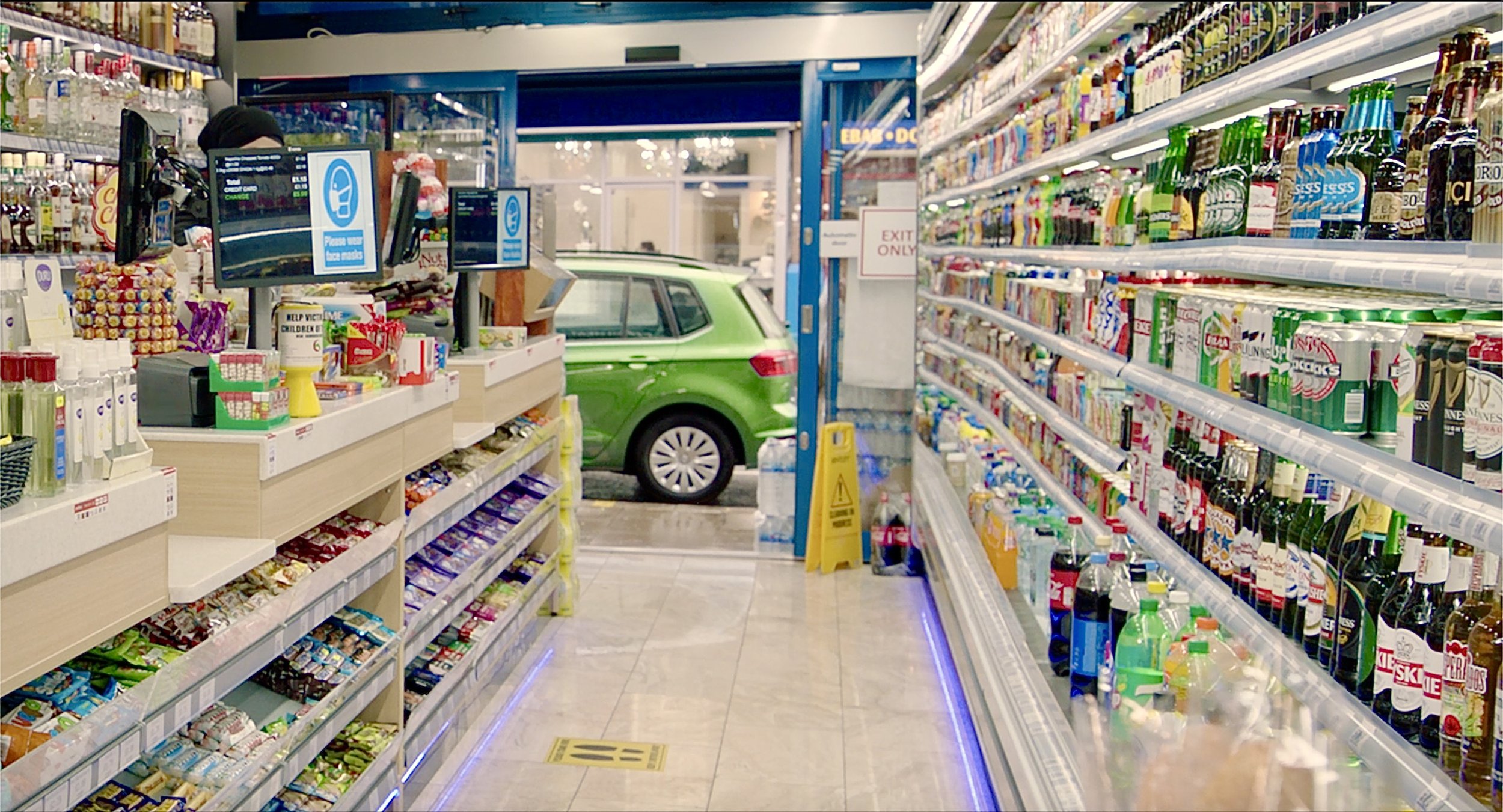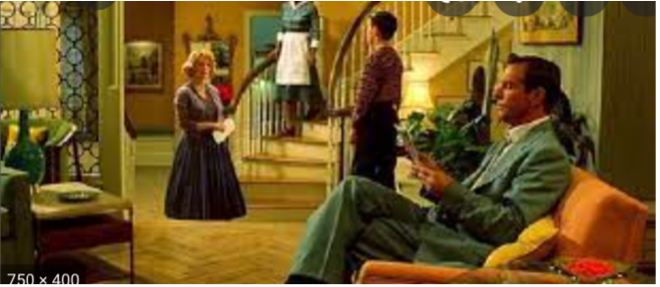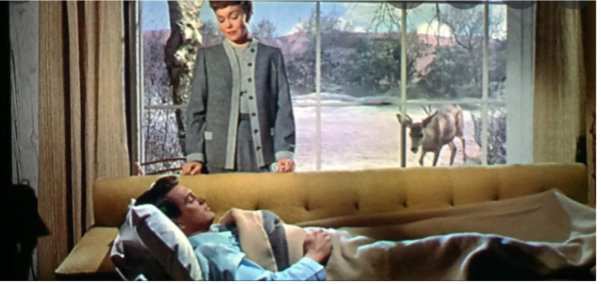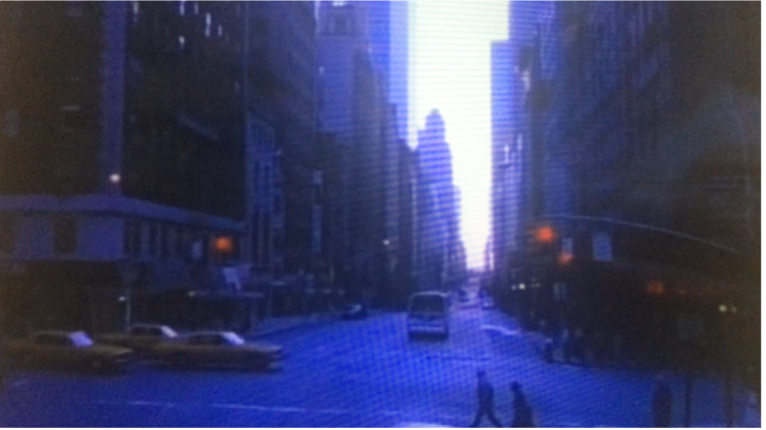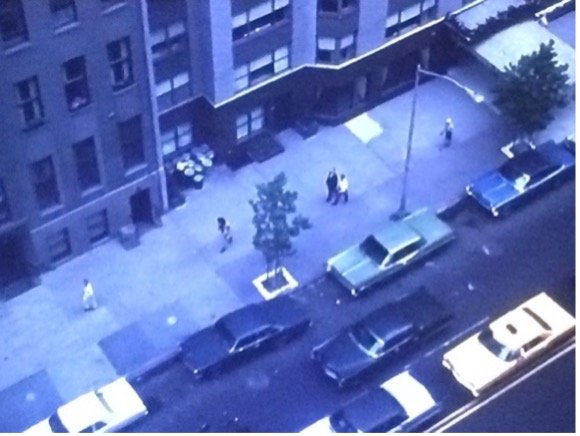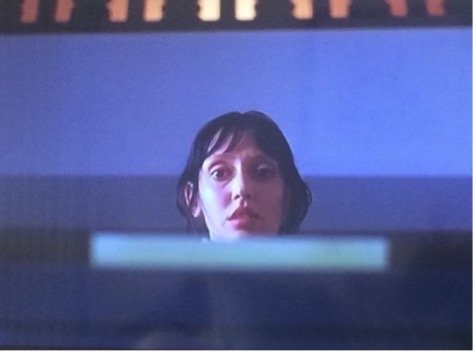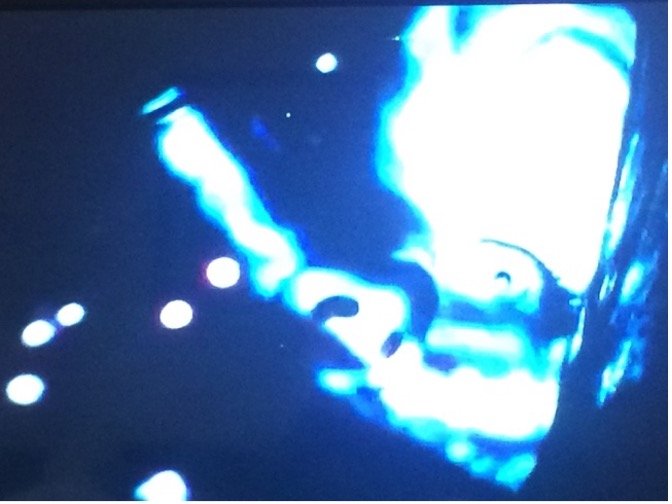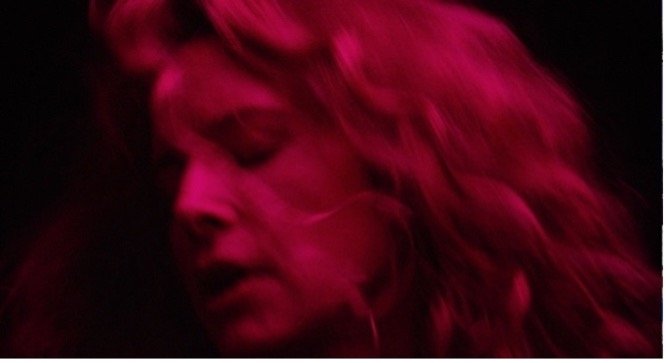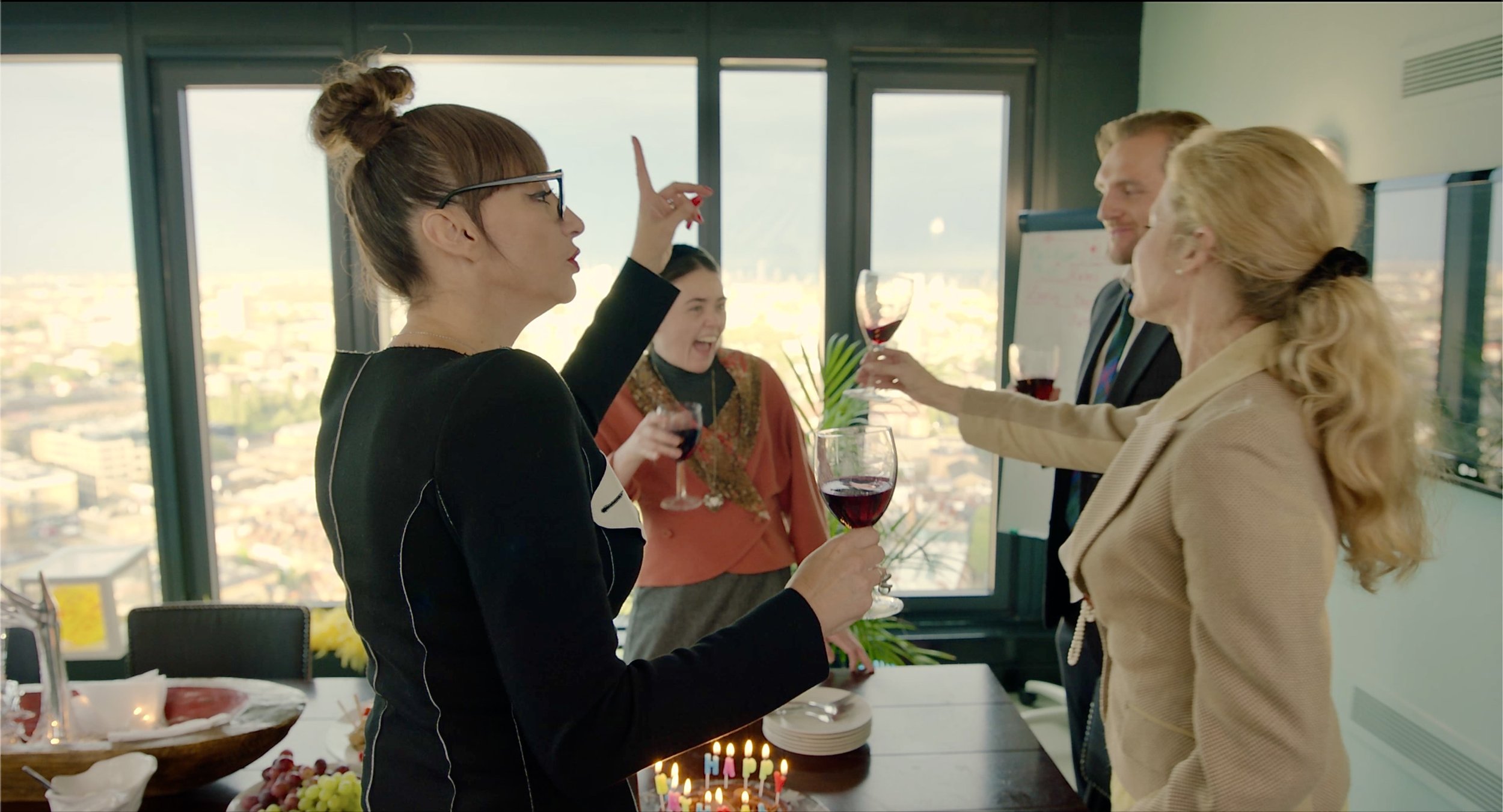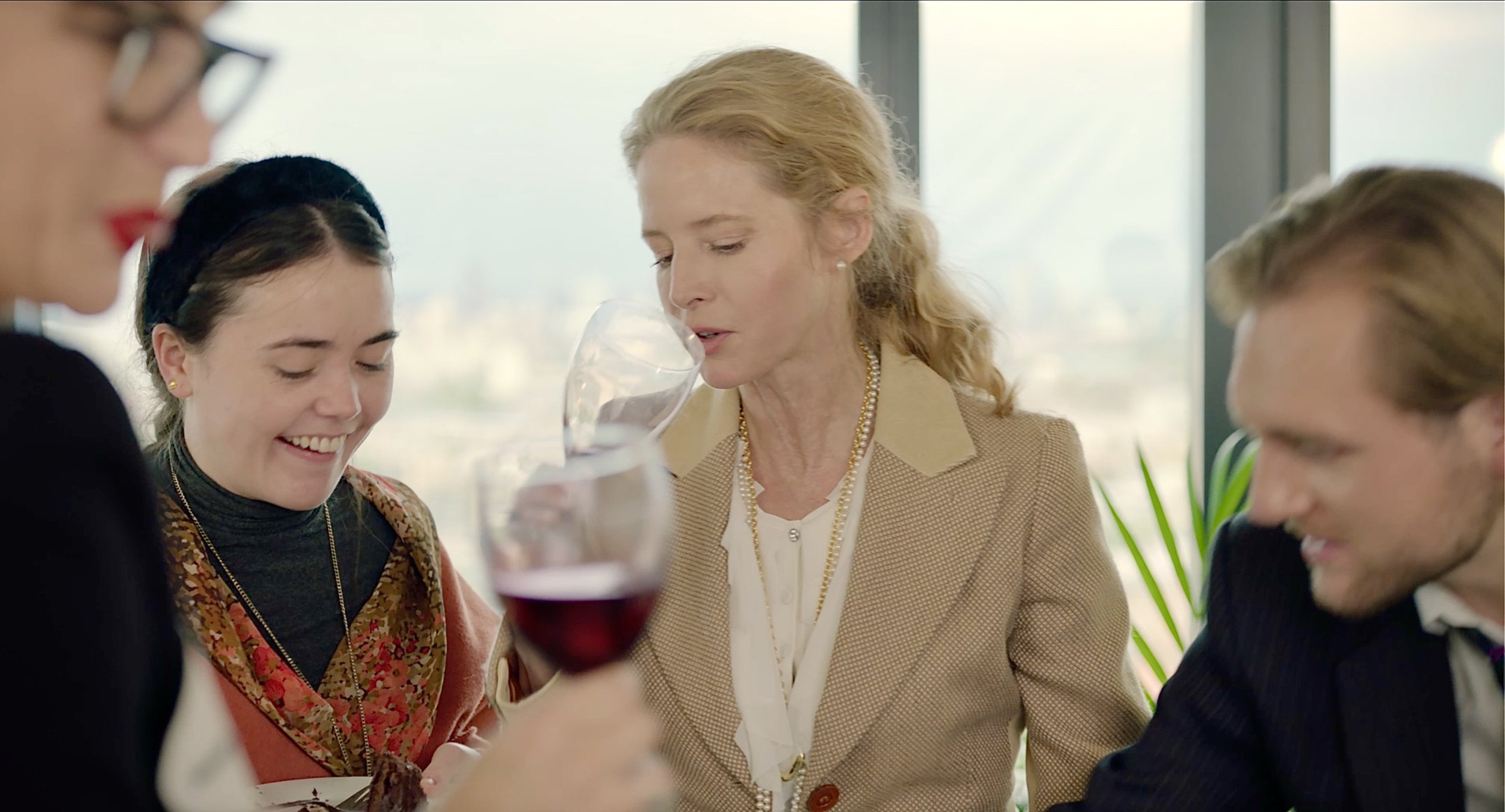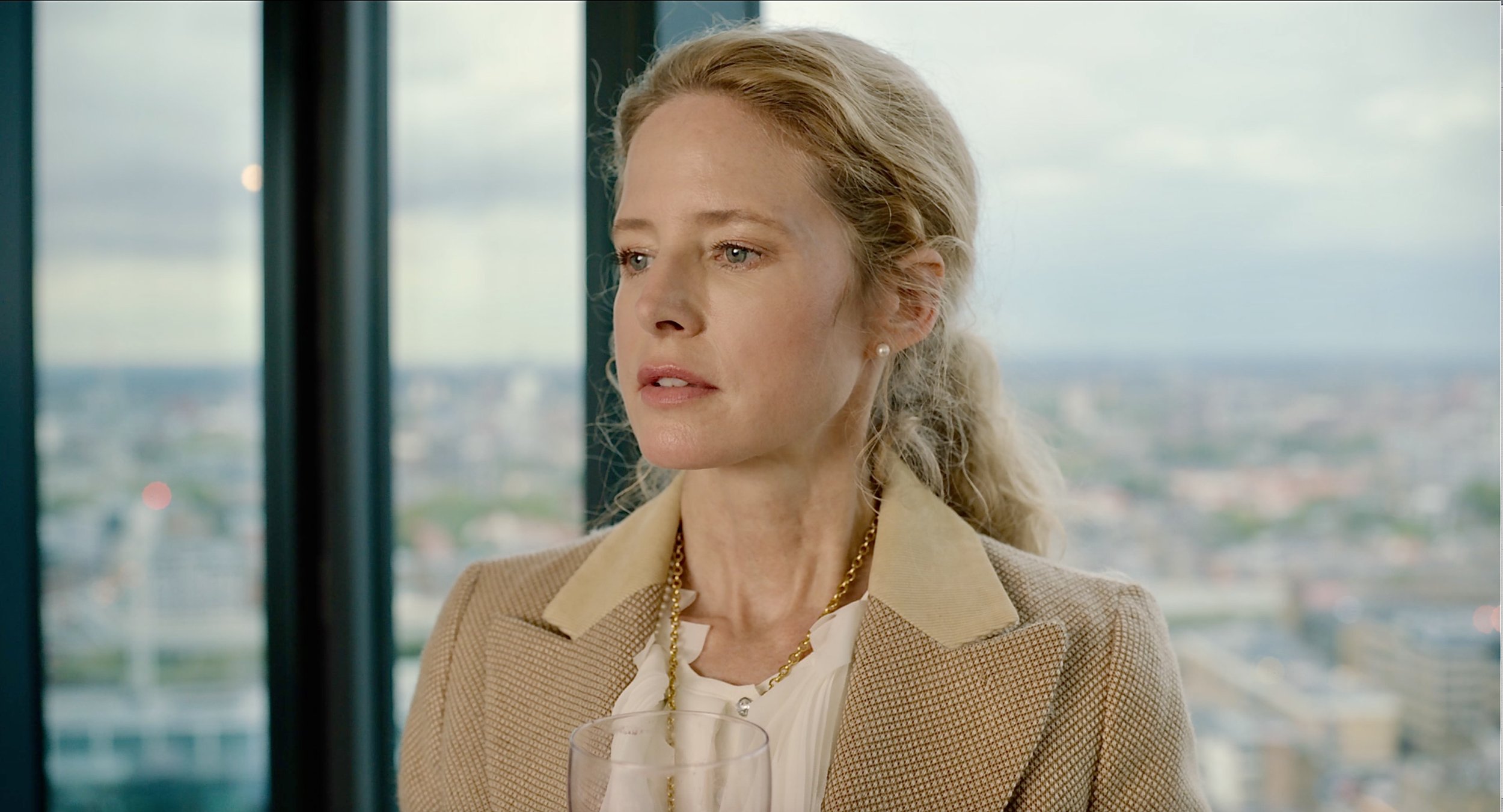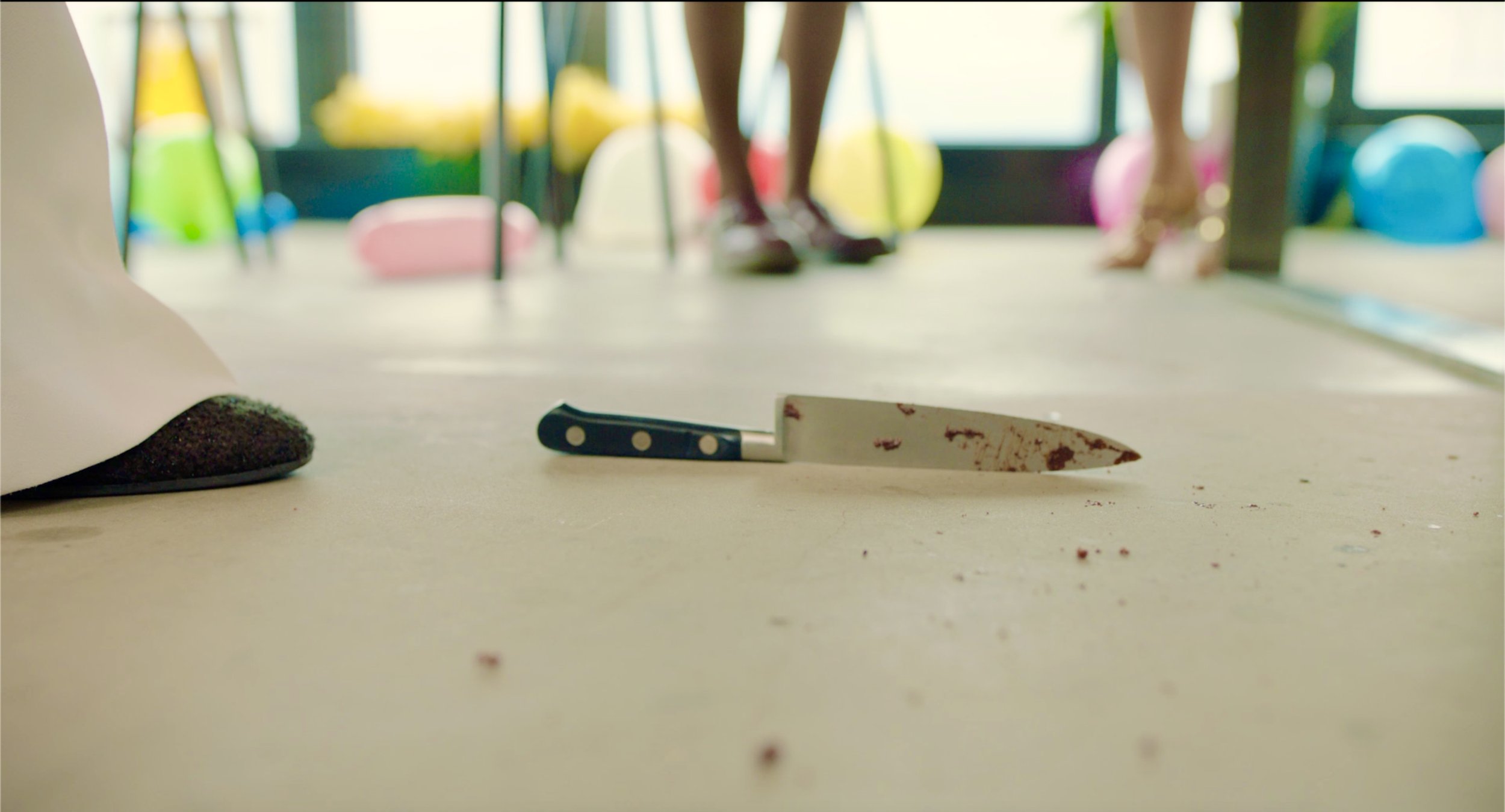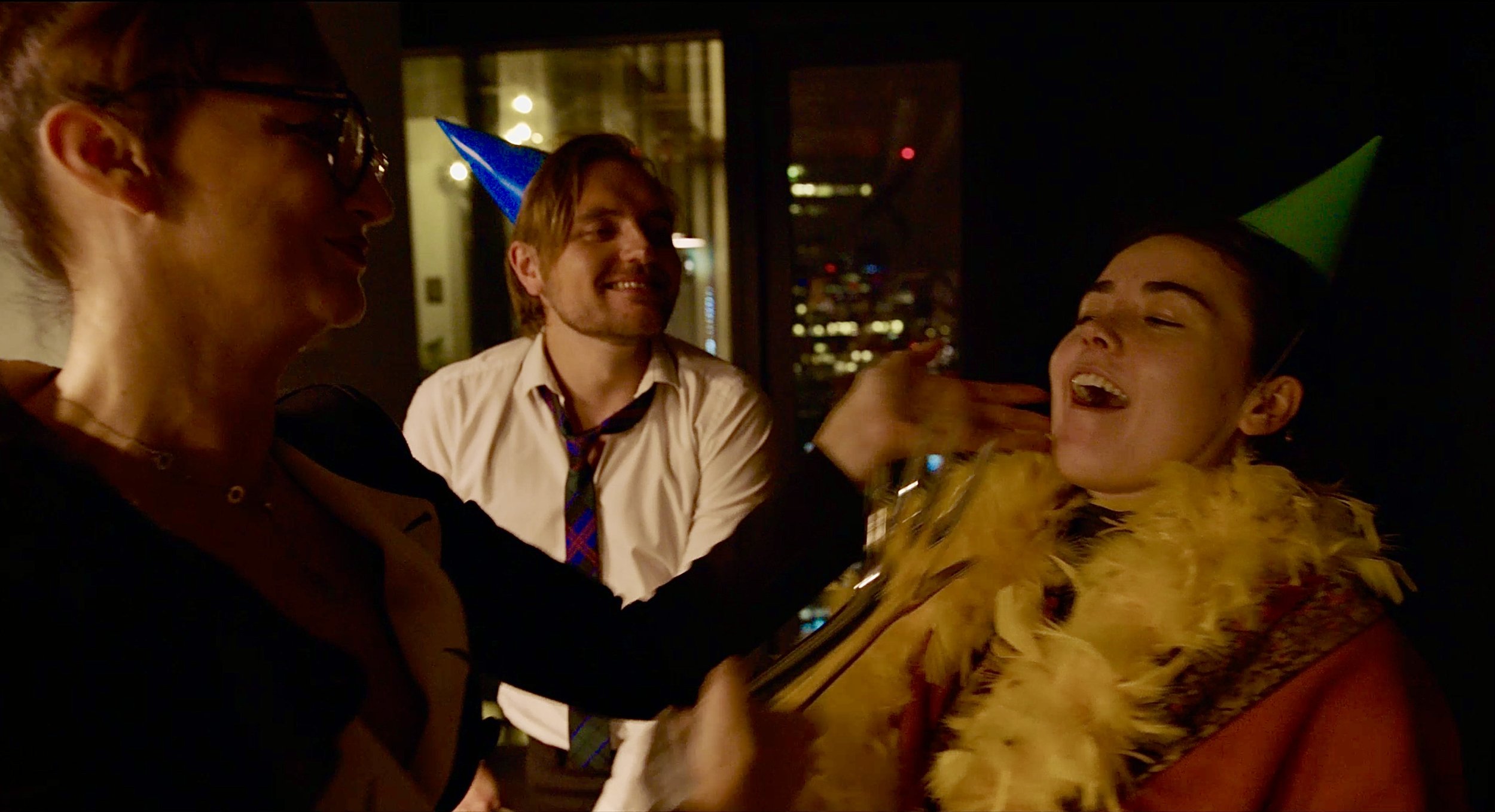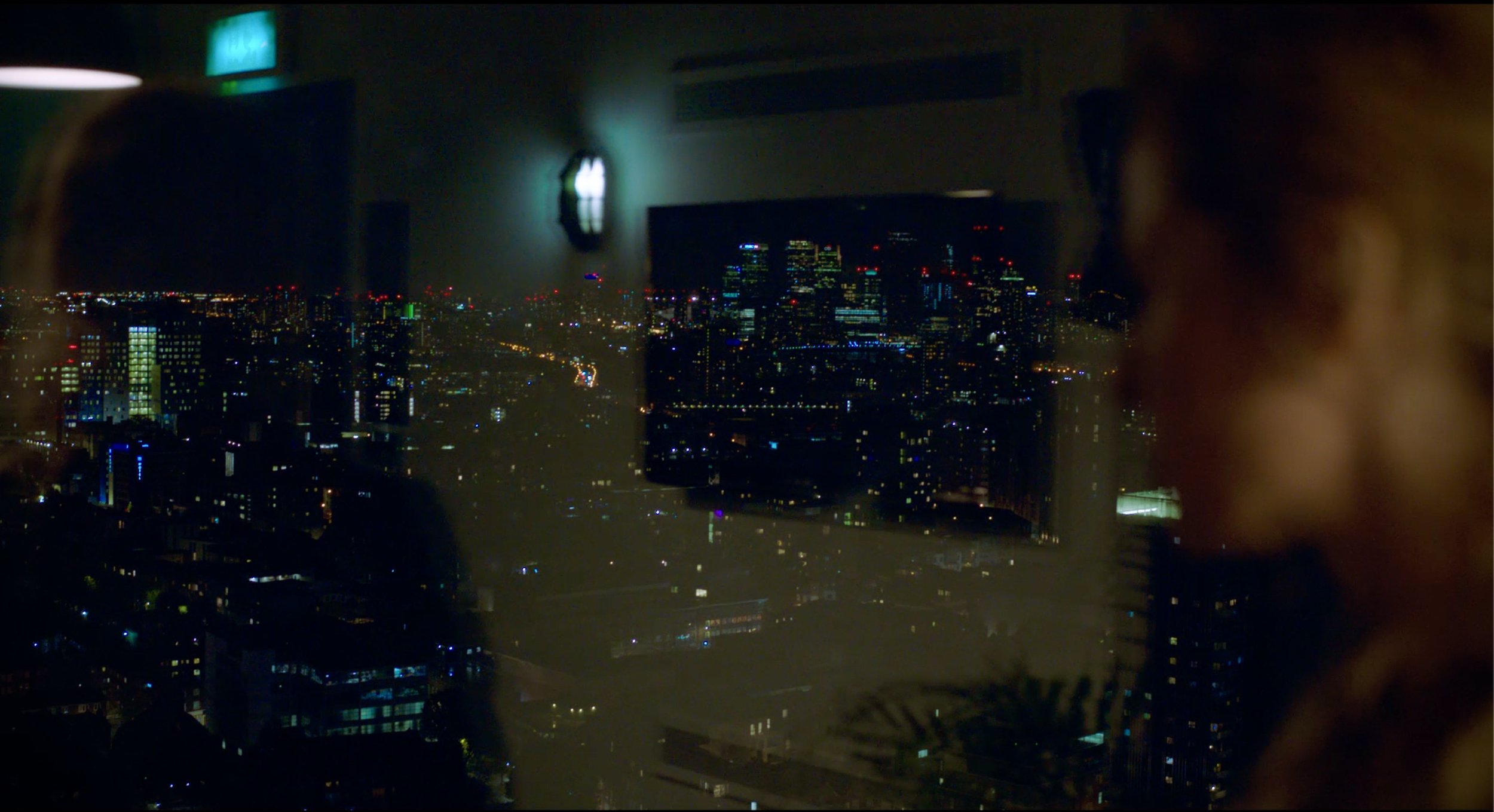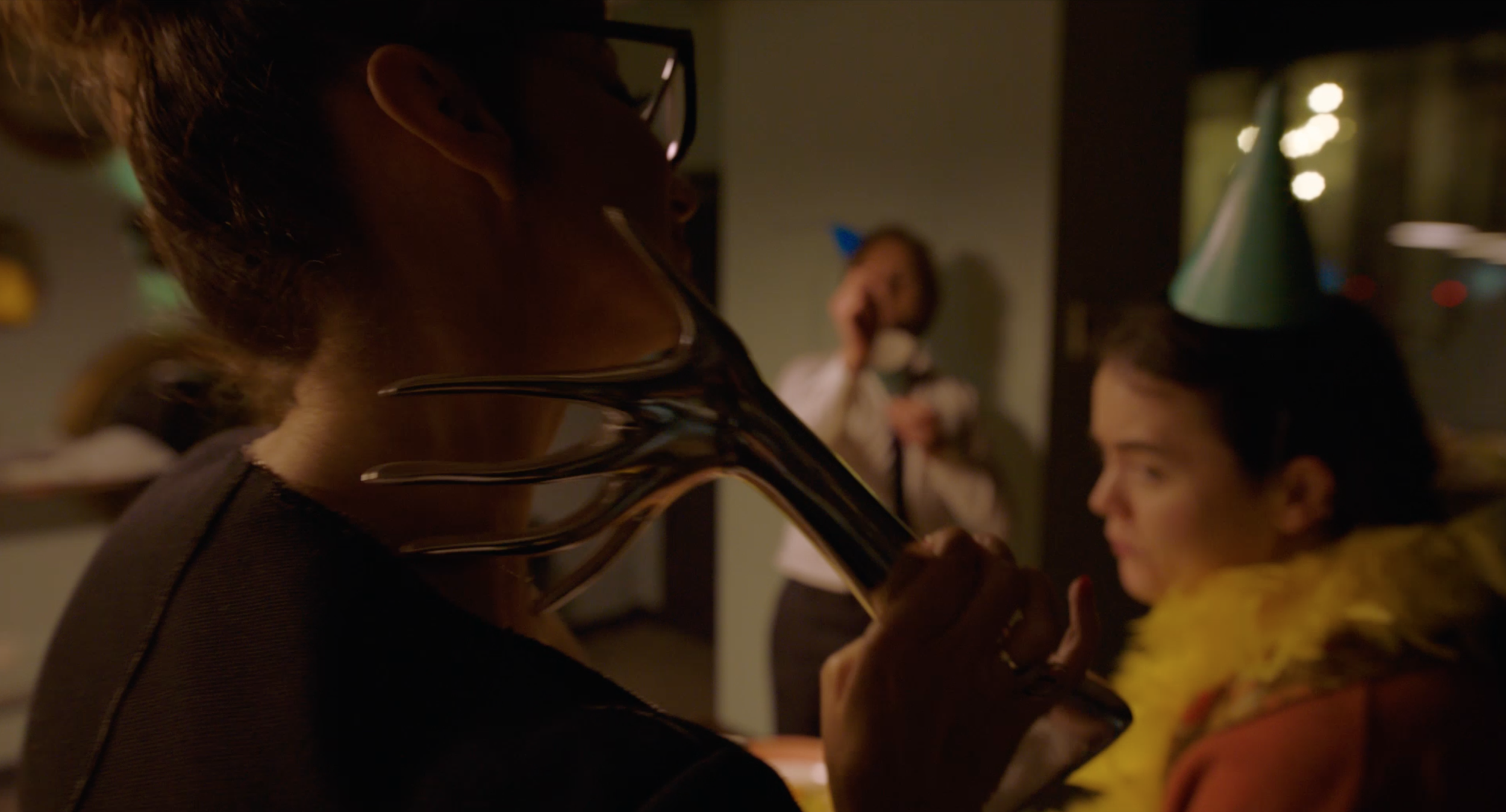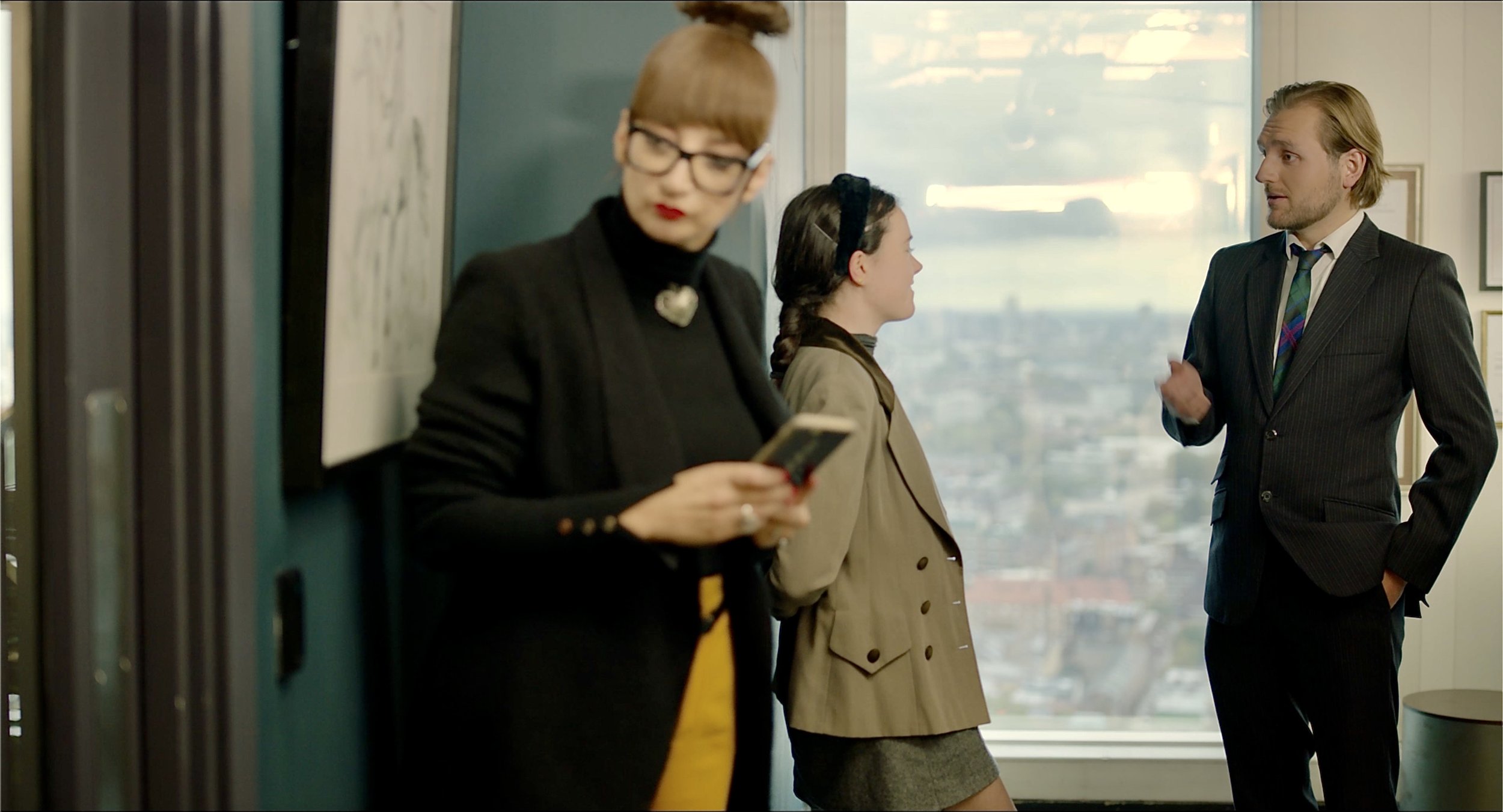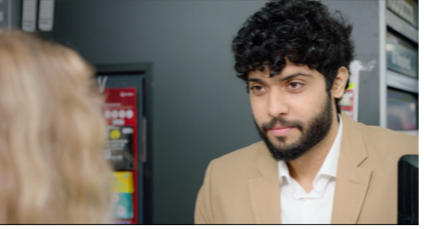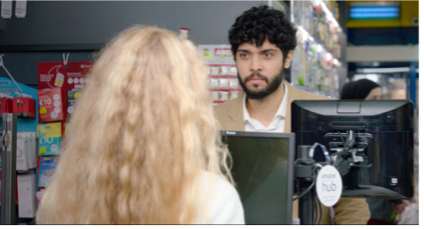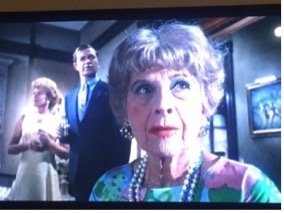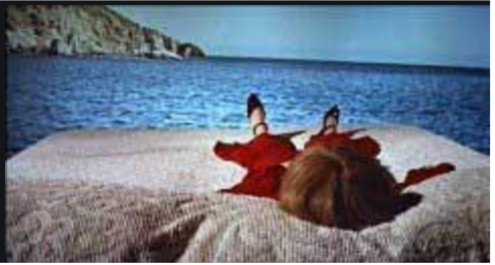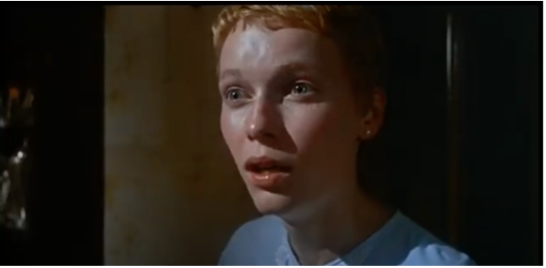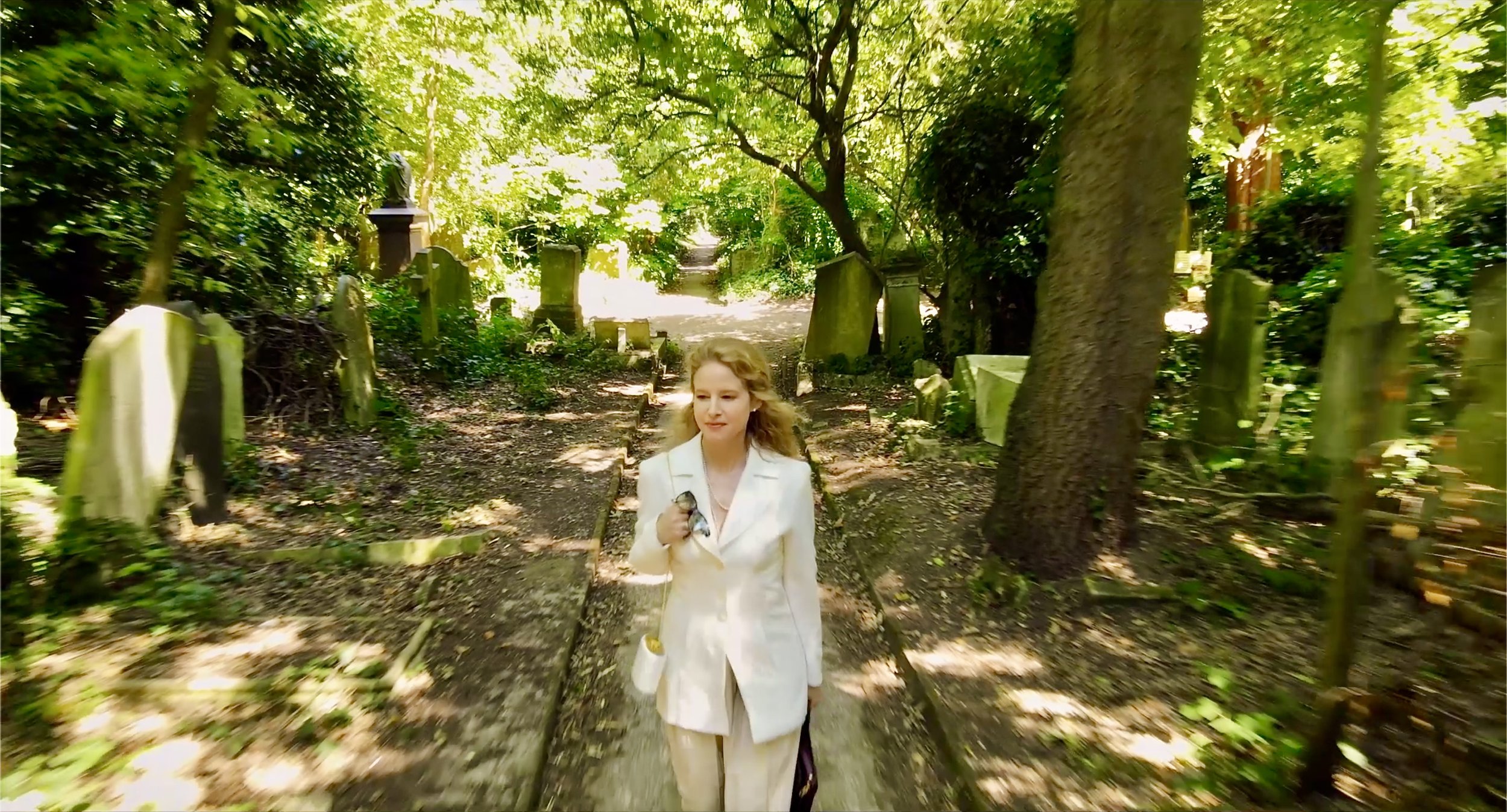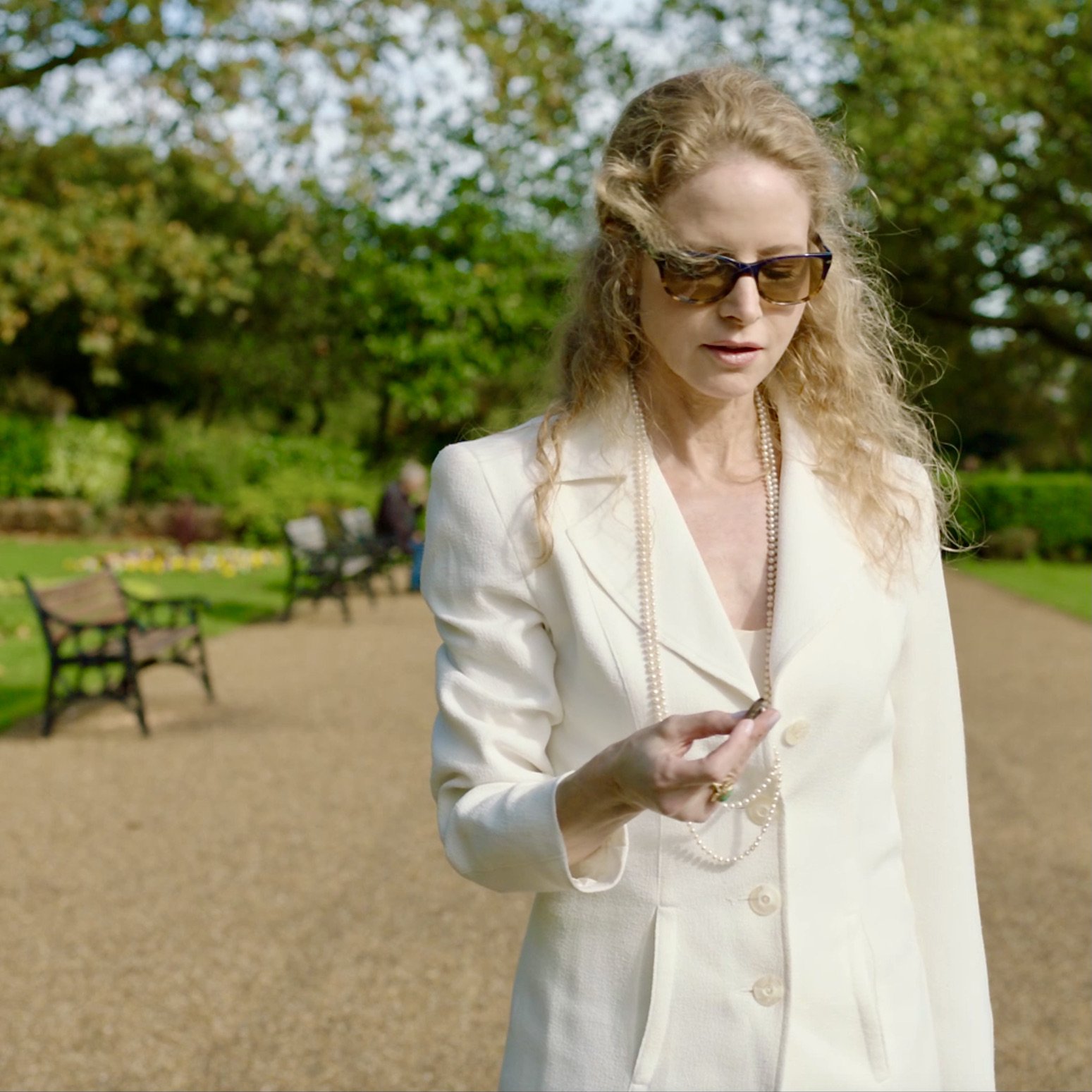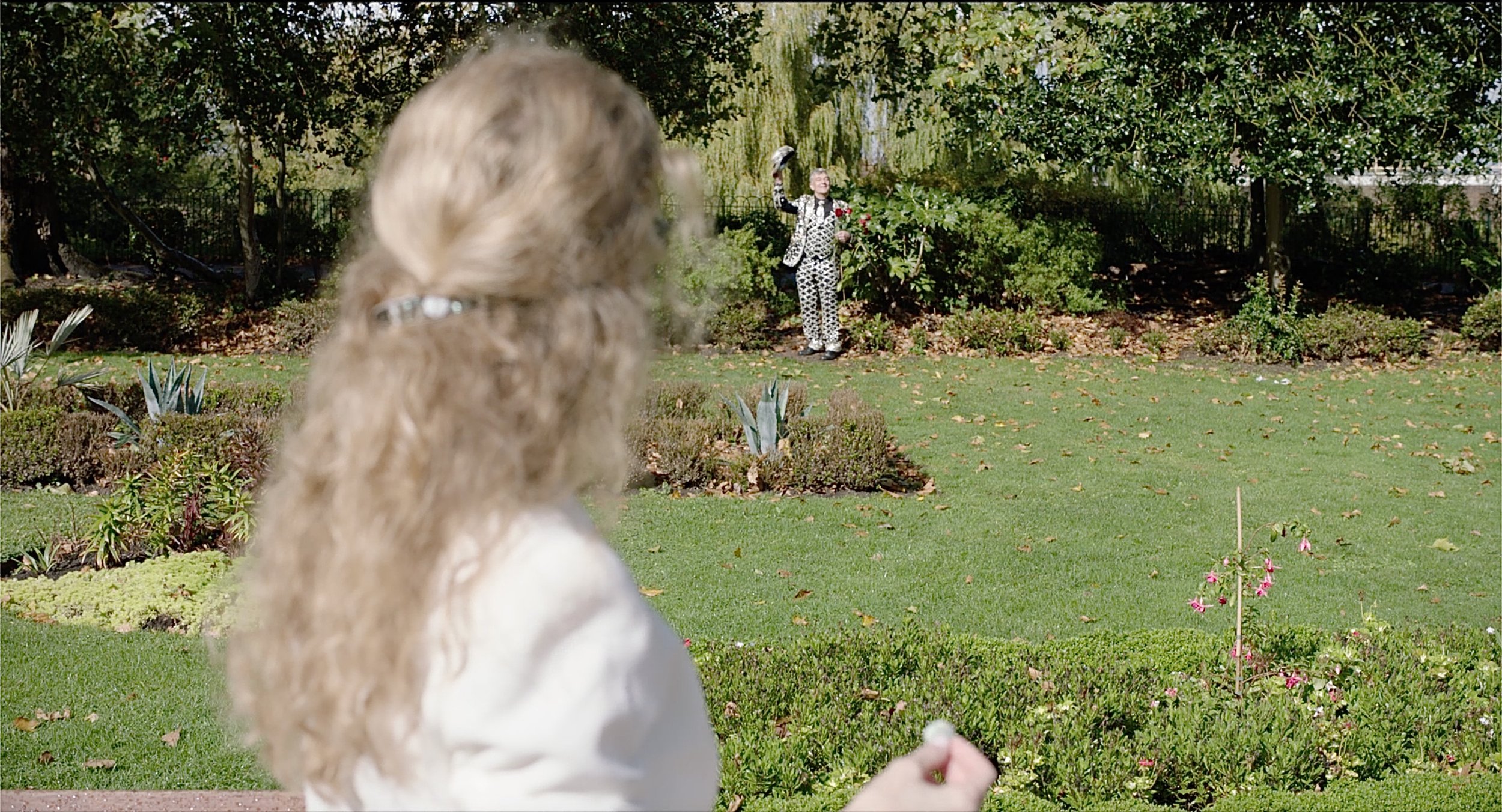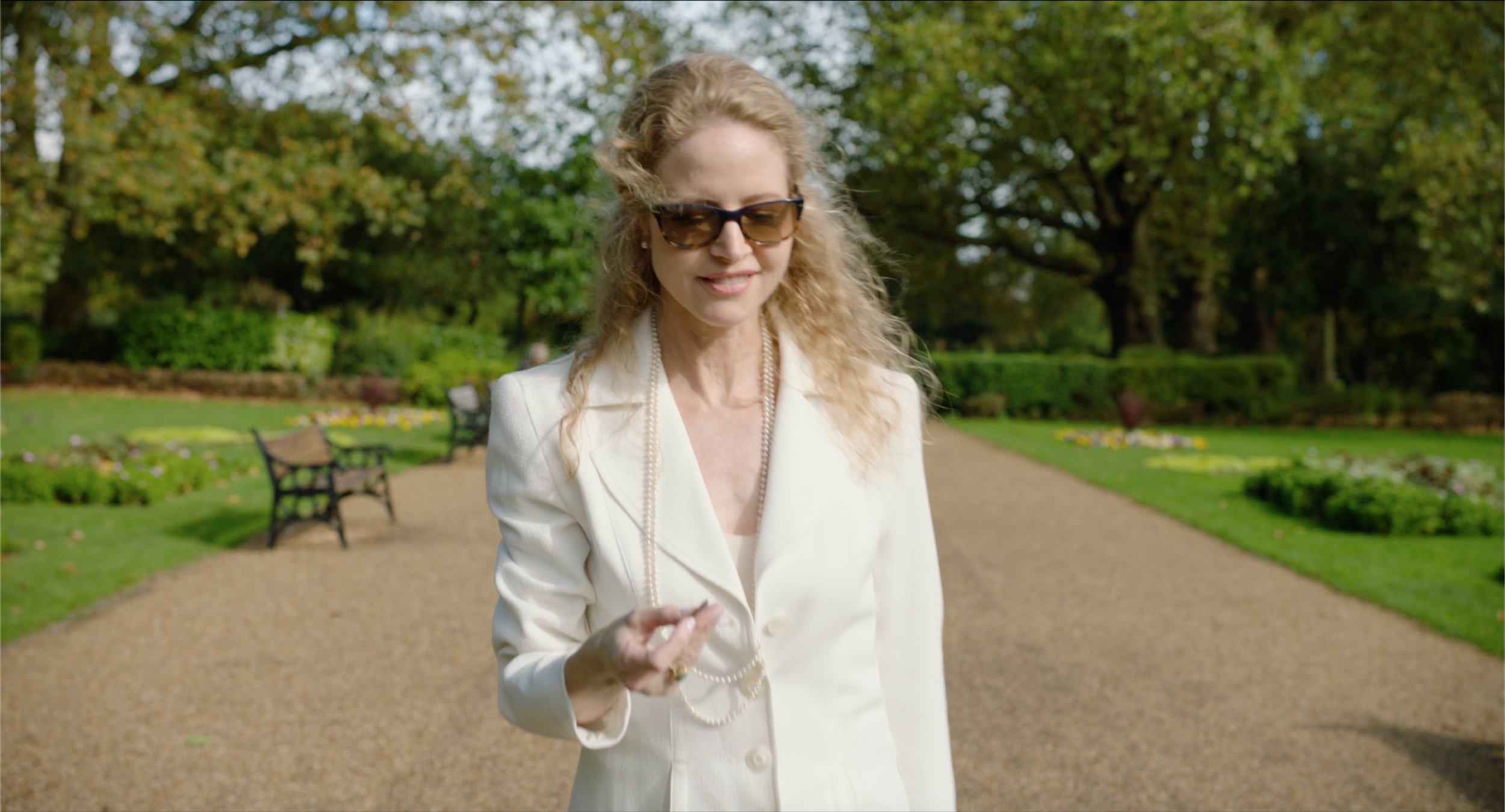‘The Yesterday’
THE YESTERDAY Official Poster - Festival Release January 1, 2022
© 2022 Baronesse Productions Inc. All Rights Reserved
Poster Art by https://linktr.ee/Vpsudev
© 2023 Chris Norman / Baronesse Productions Inc. All Rights Reserved.
With DOP Alexander Harrison & Unit Production Manager/Focus Puller Oscar Harrison
POST-PRODUCTION
Looking back at my role as Director
Well in advance of our shoot, I sent our DOP a ‘Scene Styles’ PDF with movie-inspired pictures of how I intended each scene to look and feel. In a foyer powder room scene for example, the couple discuss taking a picture, then look to the mirror.
I liked a similar composition in the film Carol (Haynes, 2015) which likewise captured a vulnerability while affirming a relationship in the enclosed space of a mirror.
THE YESTERDAY Directing Highlights
This film speaks to anyone who has questioned what really matters in life… money, stature, enjoyment at all cost? Hard work, loyalty, family?
Or perhaps what is truly enviable lies much deeper …
Two foreigners in London from differing backgrounds and ages find themselves in a love neither could have imagined. One is a young shopkeeper from India awaiting the arrival of his wife by arranged marriage; the other a mature, principled businesswoman from America.
“WE CAN’T SOLVE OUR PROBLEMS WITH THE SAME THINKING WE USED WHEN WE CREATED THEM” - Albert Einstein
The bathroom we used was quite small with a prominent unsightly shower to the right of the sink. We solved this through both production design – using lit candles to the left of the scene and several fancy toiletry additions to divert the eye - and through composition, filming through the doorway to hide the shower, slowly zooming in to reveal the reflection only as far as the space would allow. This also served to give the audience an interesting ‘peeping Tom’ view.
As our LFS Tutor Belinda Parsons in September, 2018 in Term 4 said:
“The DOP is creative and technical, but must achieve what is in the head of the Director. He must collaborate with the Director. Every film is different. And the Camera Operator must also be collaborative – he cannot choose the shot. He can work with the Director and Producer who design the shot, but only in so far as they allow“ (Parsons, 2018).
This was the dynamic I established with my DOP (also camera operator). As Director and Producer, I prepared a detailed linear storyboard with every shot I intended to use.
I went over each shot with my DOP over many hours in advance of the shoot to either confirm or improve on the shots. We saw eye to eye on most, eliminating a few and adding several at his suggestion.
I added beauty shots during the shoot as they emerged, like this ‘through the arm’ shot of Josephine with a focus pull to the Shopkeeper. In the edit I added a fade out of the couple to become visible Josephine’s arm, then turn into the focus pull on the Shopkeeper symbolizing her containing him - and them - within her.
To enhance Josephine’s sense of the city as devoid of meaning, grey, noisy, dangerous, I brought down the grade colours to reveal only burgundy browns and greys.
I chose compositions that were not particularly beautiful nor inspiring, just busy and typical of a major city.
My intention was to contrast the grey, chaotic city devoid of meaning, with the bright yet organized, sometimes artificially colourful convenience store where Josephine encounters joy and love.
This was not unlike the ‘happy colouring’ in the films Far from Heaven (Haynes, 2002) with its over-processed shades singaling plastic superficiality, and All that Heaven Allows (Sirk, 1955) with its campy lighting and bright colour - also about appearances (and an older woman with a younger man).
I love the contrast between the small and large – perspective from closeup against views from far away or high up – the micro and macrocosm in relation.
I was inspired by a shot from high up in Midnight Cowboy (Schlesinger, 1969) showing the main characters’ lives suddenly looking like those of tiny insects when the perspective changed.
We achieved something similar but in reverse, with an actual spider set against the bustling city from high up.
Breakfast at Tiffany’s (Edwards, 1961) Midnight Cowboy (Schlesinger, 1969)
(I had storyboarded a ‘Kubrick’ reverse of that shot – Josephine looking out through the plant over the city – but time did not allow).
The Shining (Kubrick, 1980)
I like stepping into different worlds of colour and light in a film – like a David Bowie concert with extreme lighting or at a drug-filled party as pictured here in Midnight Cowboy (Schlesinger, 1969).
These take us out of our conventional reality and allow a kind of escapism that transcends time and space which, in a film about thoughts and feelings, is like diving right in.
Midnight Cowboy (Schlesinger, 1969) David Bowie Concert
Janis: Little Girl Blue (Berg, 2015) – The Janis Joplin Documentary
To bridge the gap between reality and fantasy in ‘Josephine’s flat’, we created a black backdrop to dynamic surreal lighting from an LED board as she danced. It was pulled away to reveal she was actually dancing at home and ‘in the disco’ only in her head.
We used Josephine pouring herself a drink to lead the eye down and away from the backdrop that had to be removed with precision timing.
The Yesterday (von Sass, 2022)
One of the major challenges as Director during the covid shoot, was that teams in our crew could not work simultaneously. During the ‘Josephine’s office space’ shoot, this doubled the amount of time we could spend preparing - exacerbated by the management’s double-booking mistake - leaving a fraction of our intended daylight shooting hours.
I solved shooting the daylight-scheduled scene, by abandoning my detailed storyboard and capturing the essence through handheld by day, then by night, creating a two-part day/night party.
It was a good solution because it enhanced the absurdity of the surreal party itself – an office event for only four co-workers (because more were not allowed in the room) that just went on and on for hours until dark.
A crucial element of directing was obtaining the performances I wanted.
“Howard Hawks’ [answer to] naming the most important element in an actor’s performance was ‘confidence’. In a sense, that is really what’s going on during the rehearsal: the actors are gaining confidence in revealing their inner selves [...] The mutual trust is the most important element between the actor and me” (Lumet, 1996) (21).
The Yesterday (von Sass, 2022)
I agree with this point. That is why I cast people whose natural core had similarities to the characters’. My Directing Tutor (also a director) Richard Kwietniowski said in a workshop: “Ninety percent of directing is casting. Think of casting as a relationship, not a performance. How do you get the best work? You need to give actors the opportunity to react naturally, make suggestions. Actors want to do their best work” (Kwietniowski, 2018).
When I worked with the actors, I encouraged them to be themselves, to be natural, to say the lines like they (as that character) really meant them, not how they thought the character they were playing would say them.
Early in the ‘audition’ process (often quite informal), I encouraged the actors to talk and introduce themselves. I observed their mannerisms, smiles and enthusiasm to see if they could play the roles as I envisioned them. On set, it was a matter of bolstering their confidence by encouraging their natural traits – leaving it up to their natural core to manifest the character.
I felt good about the performances – the ‘over the top’ ones and natural ones alike - and took a minimum of good takes to keep everyone fresh and enthusiastic.
The last scene of the film for example – silent with only facial expressions and some movement with hands – required natural sensitivity. “The theme of a story is usually established only in the final climax during the obligatory scene where the confrontations dramatize the point of the narrative. This is the part of the story [...] where character, plot and theme are most clearly integrated. This confrontation is likely to be a high point [...] where principal characters are placed in situations designed to reveal their most significant qualities, their moral weaknesses or strengths, their sympathetic or unsympathetic traits, their true feelings about others. Such showdowns [...] give unity and meaning to the story” (Mackendrick, 2005) (26).
In the last scene, the actor playing the Shopkeeper in particular had a range of sensitivities – kindness, compassion, sadness to draw from. He was quickly able to embody the sentiment and deliver a believable, natural performance.
“So how do you shoot fast? Rehearse it until you think you’ve got it, shoot it, then forget it [...] Your movie will be made up of many parts, and pouring a lot of detail and painful retakes into each tiny moment is a waste of your time and money. It’s the overall effect you’re looking for [...] Live with the first or second take and make it work later in the edit’ (Rodriguez, 1996) (27).
“Making a movie has always been about telling a story. Some movies tell a story and leave you with a feeling. Some tell a story and leave you with a feeling and give you an idea. Some tell a story, leave you with a feeling, give you an idea, and reveal something about yourself and others. And surely the way you tell that story should relate somehow to what that story is” (Lumet, 1996) (28).
This was the question of style for my film. I wanted people to feel and think something because of the way I told the story, thereby revealing something about them and others. I wanted them to have an experience, a question and maybe some insight into how and why they and others do things as they do. To achieve this, was to let the audience sample the main character’s reality without telling them how to interpret it.
Concerning making a short film stand out, my LFS tutor said: “Make it visually arresting – like Wes Anderson – through quality cinematography. Keep it a simple story, with minimal dialogue and make every scene count. This is an exercise in expressing your self” (Kwietniowski, 2019) (29). This was what I aimed for.
The Yesterday (von Sass, 2022)
The Yesterday (von Sass, 2022) after all, is “about loneliness, about seeking the deeper humanity within the human; about awakening real love and fulfillment beneath appearances, convention and custom. I wanted to inspire a conversation about the nature of love, the human experience of time, imagination and reality, and the intricate interconnectedness of all influences - whether seemingly good or bad” (von Sass, 2021) (30).
I wanted the audience to experience beautiful filming, scenes that are intriguing, annoying, disturbing, and experience time in the way people do in their thoughts - not a linear narrative progression, not restricted to Life in a Day (MacDonald, 2011) storytelling but as
they pop in and out over the course of a day, a month - spanning memories, fears and wishes. I wanted the audience to see the various realities of the main character interspersed within her linear life, and the various ways she interacts with these and the people she meets.
I was inspired by such films as Vanilla Sky (Crowe, 2001) with its bold use of music, altered states of reality, and time jumps (where you never really know what is real, imagined, past or present); Rosemary’s Baby (Polanski, 1968) for its dream sequences, over the top characters and sense of foreboding and angst; and David Lynch’s well-documented collision of reality and fantasy and ‘something dark lurking’ beneath pleasant exteriors.
Vanila Sky (Crowe, 2001)
Rosemary’s Baby (Polanski, 1968)
When daily spurts of rain and overcast skies prevented ‘golden hour’ shots, morning sunshine and any consistent daylight filming, I had to accept nature’s terms. We had a tight, fixed shooting schedule. The new meaning of rain in the story: even in a downpour, goodness is there.
I kept all the rain shots, turning them into a feature metaphor. The sun finally came out for twenty full minutes once during our nine-day shoot in the green park scene with Josephine
picking up the button and acknowledging the Button Suit Man for the first time. We were already preparing in the pouring rain, and then the unexpected gift! We scrambled to get the shot. And we did. This became a highlight in the film and made the very most of Josephine’s transition from disillusionment to love.
The sudden warm and golden sun accentuated Josephine’s new attitude to life - to engaging with something she had easily passed by before. Now she fully walked in it.
The Yesterday (von Sass, 2022)
The Yesterday (von Sass, 2022)
Covid and the English weather were challenges to say the least, turning well laid plans upside down. But once I could embrace the opportunities I found with those things I could not change, I found unexpected gifts. I could control my response to the uncontrollable – something I may have picked up from Josephine.
And while extensive planning to the last detail should be the foundation of every film and a
mindset in filmmaking, equally the flexibility to adapt and modify as needed must be present. Life and filmmaking are part of the same unified whole.
I am grateful for a fantastic team consisting of crew, actors, professionals in post, and advisors who contributed their time, hearts, expertise and generousity in the making of The Yesterday.
THE YESTERDAY BIBLIOGRAPHY
14. Mackendrick, Alexander. On Film-making. Farrar, Strauss and Giroux. New York, 2005. p. 198.
16. LFS Moodle Site. On Producing. Sixth Term. London Film School, London U.K.
18. LoBrutto, Vincent. The Filmmaker’s Guide to Production Design. Altworth Press, New York, 2002. p. 1.
19. LFS Production Design Workshop. Matthew Button lecture. London Film School, London U.K. 2018.
20. LoBrutto, Vincent. The Filmmaker’s Guide to Production Design. Altworth Press, New York, 2002. p. 25.
22. LFS Filming Workshop. Belinda Parsons lecture. London Film School, London U.K. 2018
24. Lumet, Sydney. Making Movies. Vintage Books, New York, 1996. p. 64.
26. Mackendrick, Alexander. On Film-making. Farrar, Strauss and Giroux. New York, 2005. p. 99.
27. Rodriguez, Robert. Rebel Without a Crew. Penguin Group Publishing, New York,1996. p. 209.
28. Lumet, Sydney. Making Movies. Vintage Books, New York, 1996. p. 50
THE YESTERDAY - FILMOGRAPHY
Stiller, B. & Cornfield, S. & Cohen, E. (Producers) & Stiller, B. (Director), (2008), Tropic Thunder [Feature Film], United States & Germany & United Kingdom: Red Hour Productions & DreamWorks Pictures.
von Sass, B.V. (Producer) & von Sass, B.V. (Director), (2021), The Yesterday [Short Film], U.K.: Baronesse Productions & Philosopher Fox Films & London Film School.
Sellar, J. & Anderson, P.T.& Ellison, M. & Lupi, D. (Producers) & Anderson, P.T.. (Director), (2017), Phantom Thread [Feature Film], United States: Annapurna Pictures & Ghoulardi Film Company & Perfect World Pictures.
Jaffe, S.R. & Lansing, S. (Producers) & Lyne, A. (Director), (1987), Fatal Attraction [Feature Film], United States: Jaffe/Lansing Productions.
Ford, T. & Miano, A. & Salerno, R. & Weitz, C. (Producers) & Ford, T. (Director), (2009), A Single Man [Feature Film], United States: Artina Films & Depth of Field & Fade to Black.
Kenwright, B. & Mount, T. (Producers) & Frears, S. (Director), (2009), Cheri [Feature Film], France & United Kingdom & Germany: UK Film Council & Pathe.
Carlson, E. & Woolley, S. & Vachon, K. (Producers) & Haynes, T. (Director), (2015), Carol [Feature Film], United States: Number9 Films & Film4 Productions & Killer Films.
Allen, J. & Vachon, C (Producers) & Haynes, T. (Director), (2002), Far from Heaven [Feature Film], United States: Consolidated Film & Industries & TF1 Cinema & Section Eight & Vulcan Productions & Killer Films.
Hunter, R. (Producer) & Sirk, D. (Director), (1955), All That Heaven Allows [Feature Film], United States: Universal-International.
Kubrick, S (Producer) & Kubrick, S. (Director), (1980), The Shining [Feature Film], United States:The Producer Circle Company & Peregrine Productions & Hawk Films.
Jurow, M. & Shepherd, R. (Producers) & Edwards, B. (Director), (1961), Breakfast at Tiffany’s [Feature Film], United States: Jurow-Shepher & Spinel Entertainment.
Marshall, A. & Puttnam, D, (Producers) & Parker, A. (Director), (1978), Midnight Express [Feature Film], United Kingdom & United States: Casablanca FilmWorks.
Berg, A.J. & Gibney, A. & Jampol, J. & LeBlond, K. (Producers & Berg, A.J. (Director), (2015), Janis: Little Girl Blue [Feature Film], United States: Disarming Films & Jigsaw Productions & Sony Music Entertainment & Artemis Rising Foundation & American Masters Pictures
Marshal, L. (Producer) & Macdonald, K. (Director), (2011), Life in a Day [Feature Film ], U.S.A.: Scott Free Productions & YouTube, Inc. & LG Group.
Cruise, T & Wagner, P. & Crowe, C. (Producers) & Crowe, C. (Director), (2001), Vanilla Sky [Feature Film], United States: Cruise/Wagner Productions & Vinyl Films & Summit Entertainment & Artisan Entertainment.
Castle, W. (Producer) & Polanski, R. (Director), (1968), Rosemary’s Baby [Feature Film], United States: William Castle Enterprises.
Lynch, D (Producer) & Lynch, D. (Director), (1977), Eraserhead [Feature Film], United States: AFI Centre for Advanced Studies.



